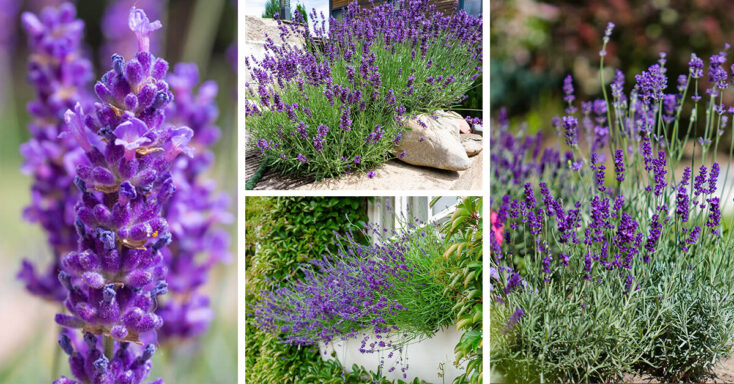If you want to make this plant thrive in your garden, this guide has everything you need to know about the basics of lavender care.
Key Takeaways
- Add lavender to your outdoor aromatherapy garden. The scent creates an aura of peacefulness.
- Lavender plants are nearly impossible to kill.
- Some of the best companion plants for lavender are rosemary, sedum, coneflower, sage, and oregano.
- Dampness is responsible for whether lavender fares well or fails.
Lauding Over Lavender
You take a walk-about in spring. A light, refreshing, and familiar fragrance lingers in the air. You turn a corner, and (as expected) a lavender shrub greets you with vibrant purple flowers. There is, in fact, a nearly universal recognition of lavender’s scent.
For those with black thumbs, lavender is an ideal plant. You really have to TRY to kill it. With this in mind, if you’re a beginner gardener, you will enjoy working with lavender.
Certainly, lavender looks lovely in your landscape. But this shrub offers much more than visual appeal. The aroma reduces stress, has culinary applications, attracts pollinators like bees, and is a drama-free plant when it comes to maintenance. Lavender oil goes into candles, soap, sachets, and many other products. If you’re the crafty sort, lavender can become a valuable part of your “kit” (both fresh and dried).
Root Word: Lavender comes from the Latin “lavare” meaning “to wash.” The scent is “clean,” which is why it’s often used in bath and cleaning products. Properly applied, Lavender helps those with insomnia, relieves burns, and, in compound form, works to ease sore muscles.
Basics of Outdoor Lavender Care
Before planting, look for a spot in your yard with good drainage. Separate the plants 2 feet. The average mature size is 2 to 4 feet tall. If you have the ability, drip irrigation is best for lavender. Overhead watering promotes disease.
When you don’t have soil suitable for lavender, use raised beds or a container for your plant. It’s easy to amend raised beds to create a media specifically for lavender—these shrubs like mulch and pea gravel. Top the soil around your plant come fall with straw, evergreen branches, and/or mulch for protection.
Containers avoid crowding, and you have far better control over the soil composition. For people with harsh winters, the container allows you to move your plants to a safe location.
Wait until spring to prune the plants when new growth appears. Get rid of obviously dead bits and shape the plant.
Lavender first put down roots in the Mediterranean, southwestern Asia, and northeast Africa. Egyptians held lavender in such high regard that they used it as part of the mummification process. Greeks used lavender to treat living people, specifically as a means to ease headaches and indigestion.
Outdoor Lavender Needs
- Sunlight: Lavender is a sun lover; full light is no problem! Some afternoon shade, however, is welcome.
- Soil: Lavender requires well-drained, moderately fertile soil. Alkaline should be just slightly above average (pH 7.0). You can achieve this by using lime. If you’re not certain, get your soil tested. Knowing what you’ve got will help you create the ideal growing media for each of your garden’s plants.
- Planting: The timing for planting depends on where you live. If you’re in the USDA Zone 7 to 10, plant early in the fall. This supports root growth. If you’re in an area colder than Zone 6, plant come early spring. Remember to give your lavender space. It needs good air circulation.
- Watering and fertilizing are both in moderation. Lavender is drought tolerant. Giving your plant too much water stresses it. As for fertilizer, unless there’s a specific issue, you don’t need to feed lavender shrubs.
The Symbolism of Lavender: In the Language of Flowers, lavender means devotion, serenity, peace, and purity. Throughout history, lavender had ties to cleanliness. Because it represents faithfulness, lavender is a popular bridal flower.
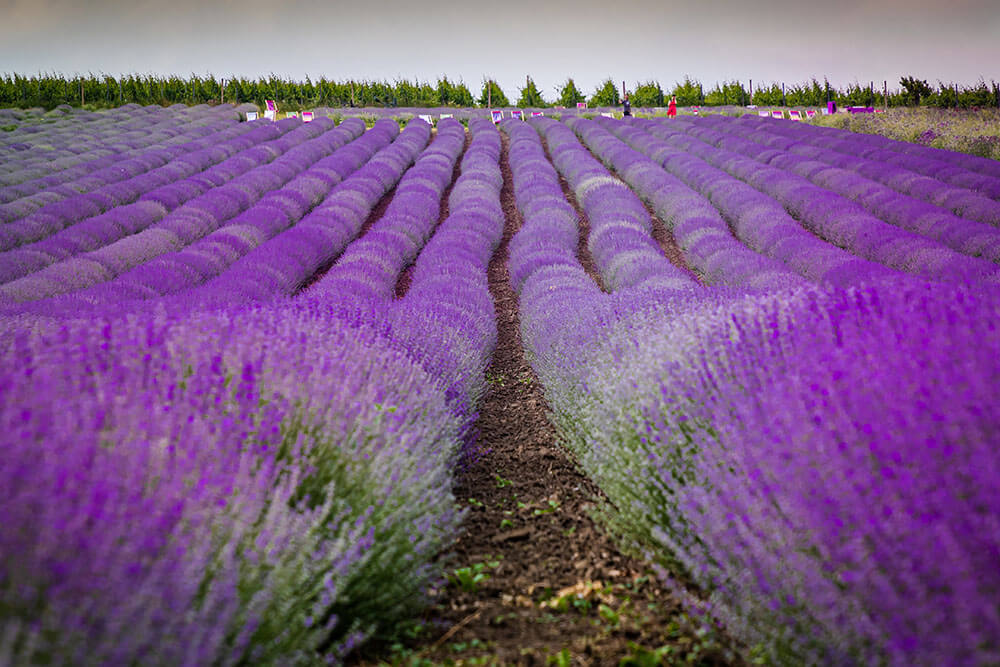
Procuring Lavender for Garden and Landscaping Plans
The pictures you see featuring lavender are typically English lavender, but there are 45 species of lavender and 450 cultivars. The key differences between them are how well they tolerate heat and cold and the size of the plant and its flowers.
Fringed Lavender: a three-foot plant with 1 ¼ inch leaves covered in fine wool. The flowers are dark purple. It is commonly grown as an ornamental plant.
- Hidcote: An English lavender that grows no more than 24 inches tall. Its flowers are deep purple and have an amazing scent. Drought tolerant once established. Thrives in containers.
- Irene Doyle (Two Seasons): Unique among lavender in that it can flower twice. The essential oils are of commercial quality. It blossoms in light purple flowers and grows to a height of 18 inches.
- L. Lady: The winner of the All-American Selection in 1994. This lavender germinates in 2-3 weeks and blossoms in the first year. North of zone five, L. Lady is an annual. In zones 5-8 it is perennial. Mature height 16 inches.
- Lanata: This is a wooly lavender with balsam notes to its fragrance. It grows into a 2-3 foot shrub, which blossoms midsummer in smoky purple leaves.
- Mini Blue: A compact lavender that grows well in a container and makes a good edging plant. One choice among various lavender flowers that is useful in culinary applications. Height and spread, 12 x 14 inches.
- Munstead: This lavender appeared in the early 1900s. It is an excellent container or hedge plant and fits neatly into a knot garden. Munstead produces delicate periwinkle flowers in summer, with a mature size of 18 inches.
- Phenomenal: A vigorous lavender; heat tolerant & cold hardy. These grow into a mound shape. The flowers hoist atop 32-inch stems.
- Provence: This shrub has an intense fragrance. It doesn’t mind poor soil, and it’s one of the tallest varieties of lavender. Grows up to 3 feet tall—a good consideration for a scented hedge. Silver-green leaves highlight mauve flowers.
- Spanish Lavender: This shrub grows four feet tall. It yields ⅜ inch-pink to deep purple flowers in late spring to early summer. They’re beautiful for drying. These are delicate plants, so treat them with a little more care.
- Twickel Purple: A maximum height and spread of 2 feet. The amethyst blossoms appear from June to August. Cut this plant in spring every three years for dense flower clusters.
It’s understandable that you might think lavender plants bear only lavender flowers. Many lavender varieties do come in purple shades. However, you can find some that are pink, white, and yellow. The color of the flower does not impact the plant’s aroma.
Watering Techniques for Outdoor Lavender
If your lavender plants look droopy and dull, they need water (compared to the normal satin sheen on the foliage when properly hydrated). When you check the soil, the first two inches feel totally dry. It’s time to water thoroughly.
Younger plants require more water than established ones. Water mature lavender every two to three weeks until it blossoms. After that, water once a week until you harvest the flowers. Note that lavender growing in pots dries out more quickly than those in the ground.
It’s best to water your shrub first thing in the morning. As the plants move into dormancy, decrease your watering, letting the soil become parched between applications.
Under a Spell: In magical methods, lavender comes under the rulership of Mercury and the Element of Air. Mercury helps with communication. Air expands the imagination. An adept may use lavender in spells for love, peace, inner serenity, and joy. Lore has it that lavender carried in a sachet protects the bearer against evil spirits.
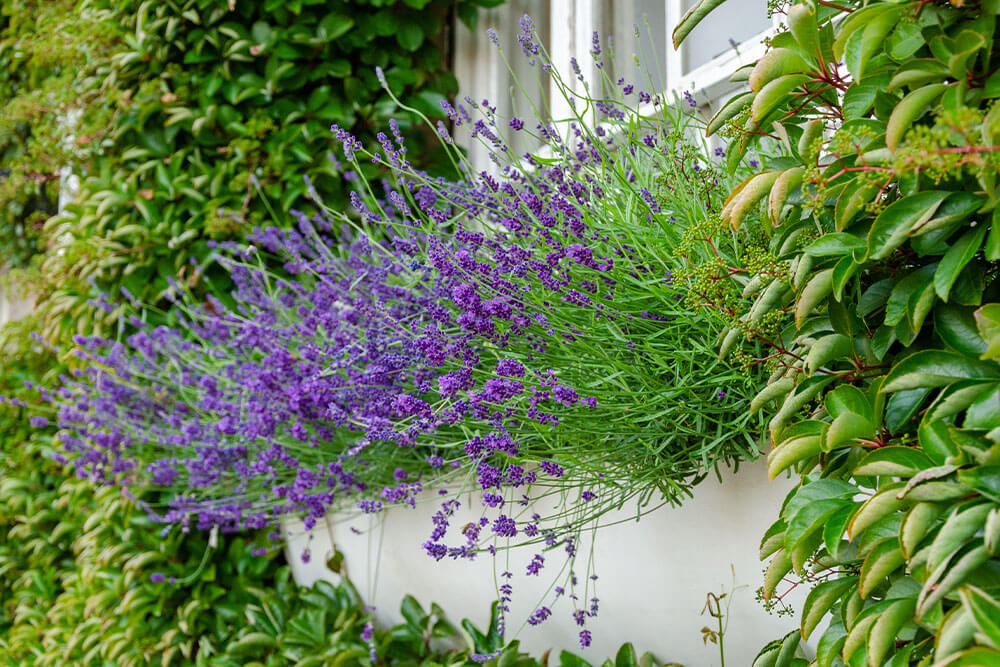
Outdoor Lavender: Potting & Repotting
In order to pot your lavender, you’ll need a container twice the size of the root ball, both in width and depth. Now is the time to amend the soil, making sure it has all the nutrients your plant needs. Mix soil with sand and small gravel to aid with drainage.
Ruffle the roots to loosen old soil. Place the shrub so that the top of the root ball coincides with the soil line. Backfill and press firmly to secure the roots—afterward, water only when the weather conditions call for it. Your plant should never have soggy soil.
You can move mature lavender plants to new locations. The change can be for any number of reasons, like planting in the wrong location or a new plot development. No matter what, wait until spring or early summer for this project.
Begin with a pitchfork moving down and beneath the plant. The roots may give you a hard time along the way. When you’ve gotten as far as possible with the fork, push the handle downward. This elevates the plant at the roots. At this point, remove any weeds.
Dig a new hole. You want the plant living at the same depth as the height of the crown in its new space. Fill the hole with water, letting it soak it. Put the lavender in the center of the hole and start filing all around it with soil. Pack it lightly. Now, carry on taking care of the shrub as normal.
Lavender isn’t a true herb because it has a woody stem. It’s a flower because it blossoms, but it is still a shrub. Nonetheless, lavender receives treatment like an herb because of its culinary applications. Gardeners everywhere often include it in their kitchen garden mix. You may not know this, but lavender protects against insects, especially mosquitos! Place some fresh cuttings around the area where you’re sitting outside, or rub a few fresh flowers on your skin.
Best Practices for Pruning and Maintenance of Lavender
Prune after the first flowering and after the last blossom fades. Remove about ½ to ⅔ of the bush’s height, making sure to leave two sets of leaves on each stem. Step back as you cut, looking for a mound form. Doing this twice a year maintains the lavender’s compact shape and supports healthy root development.
Lavender in the Bible: The Greek term for lavender is spikenard, which is how the plant appears in the bible. This plant’s scent was by far the star of most mentions. The oil became perfumes. It also became an anointing tool for purification and healing.
In the Gospel of John, lavender was part of the ointment used to anoint Jesus’ feet. The Song of Solomon mentions lavender twice as part of a love poem (1:12, 4:13). One tale says Adam and Eve took lavender from the Garden of Eden. It didn’t receive its scent, however, until Mary laid Jesús’ clothes on a lavender bush.
Lavender Blooming and Resting Periods
English lavender blooms in late spring and again in late summer. A hybrid of English lavender (intermedia) blossoms in late summer. Spanish lavender is an early spring bloomer.
All lavender plants experience winter dormancy. Their leaves turn from green to sage green and start dropping. If you live in the north, avoid pruning in winter. Deadhead them, but no getting into the branches. Use spent leaves around the base of the plant to help keep it warm.
Lavender in Egypt & Greece: Egyptians so revered lavender that they used it in mummification. They embalmed the entire corpse with perfume. The Greeks went in a different direction. Instead of focusing on the dead, they use lavender to treat insomnia and ease back pain among the living.
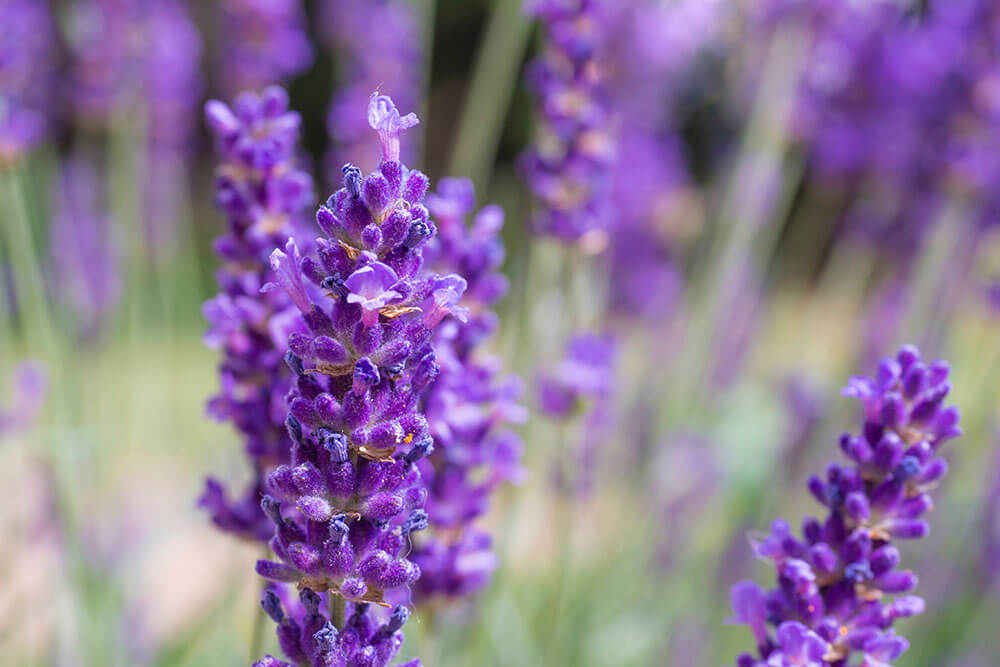
Common Pests & Plant Diseases in Outdoor Lavender
Root rot is aggressive in lavender. It happens when the soil is chilly and wet. The leaves in your plant begin to yellow and brown. It looks wilted even though it’s been watered, and growth slows. There may be an unpleasant aroma near the base of the plant, too. Pay attention to the weather. If nature gives you rain, don’t double down by watering the lavender. Sand, gravel, and peat moss amendments to the soil can improve drainage. Also, trim away dead or dying pieces of root, and apply a natural fungicide like baking soda.
If your lavender bush has aphids, it may develop the Alfalfa Mosaic Virus. The plant’s growth slows, and the leaves look yellow and mutated. When you recognize the problem, immediately cut away all affected plant parts and dispose of them away from your garden. Make sure to clean your gardening tools well.
Botrytis looks white and fuzzy. The plant’s leaves are yellow, wilt, or die. Your best protection against Botrytis is having good drainage. Waterlogged soil encourages this disease. Also, make sure your plants have at least 2 feet of space between them. Apply Neem regularly until the issue resolves itself.
What of creepy crawlies? Spittlebugs can be problematic. The key signs they’re around are little bubbles of foam on your plant. While these critters won’t usually kill your lavender, they can damage stems. Rid yourself of them by making a garlic pepper spray and applying it to the plant.
Whiteflies look similar to aphids. A strong water spray can knock them off your plant. Whiteflies suck the sap of your plant. To prevent this, put aluminum foil at the base of your shrub when you pot it. Surround the lavender with companion plants like dill.
Lavender is part of the lamiaceae, and has some interesting relatives you’ll probably recognize immediately. The commonalities in this family boil down to having powerful aromas and often natural medicinal qualities. For example, there’s the mint bush and germander, both popular for tea. Basil is a popular cooking herb, as is sage.
Troubleshooting Common Problems in Lavender Plants
- Not flowering: Your plant needs more sun (6 hours daily). Or, you may be using too much fertilizer, giving your plant too much (or too little) water, and/or pruning it improperly.
- Dying: Song soil. Make sure your plant has proper drainage. Alternatively, your plant may have experienced winter damage.
Tea Time: English lavender makes excellent tea, both in taste and aroma. Always use fresh, organic lavender for best results (make sure it’s pesticide-free). To make your tea, boil water in your kettle. Place ½ tsp lavender in a tea strainer and place it in the cup. Pour water over top and let the tea steep for five minutes. Add sugar or honey to taste.
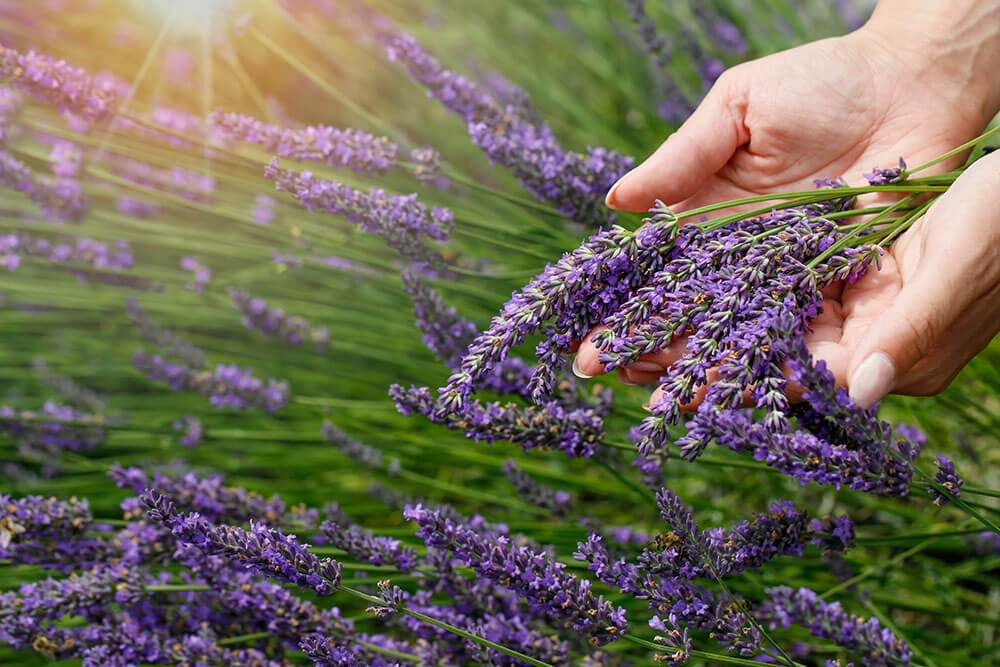
Summary
Lavender is a garden staple. You can use it for its beauty, enjoy the bright aroma, cook with it, or use it for holistic wellness. Of course, an outdoor shrub can succumb to diseases or insects. For the most part, however, lavender is pretty resilient. If you maintain your plant in well-drained soil, you’ll be surprised at how easy it is to care for lavender plants.
Frequently Asked Questions About Lavender Outdoors
Should you cut back lavender?
Pruning not only keeps lavender looking good but also keeps it healthy. When you take care of your shrub properly, it can live for up to 20 years.
How do you keep lavender blooming?
Trim your English lavender just after the first flowering. You should see another round of blossoms in August.
Does lavender last all year?
It depends on your growing zone. If you live in USDA zones 5-10, lavender is an evergreen perennial. In colder areas, lavender dies after the frost unless you protect it somehow.
Can lavender survive winter?
You can use reliable snow covers or use pea gravel and mulch at the base of your plant. Burlap makes an effective blanket from the wind. Or, you can move your plants int a shed or garage for overwintering until the threat of frost passes.
Does lavender come back to life after winter?
If you follow good care practices, lavender will return year after year. It needs plenty of sun, a little water, and good drainage to remain healthy.
Lavender has a nostalgic resonance to it. Around my neighborhood, you’ll see these shrubs planted in front of glorious Victorian-style homes. I can imagine being there on a lovely day with tea and conversation. The fragrance is immediately recognizable and wonderful, and I use it in cooking too!

